Working professionals
Fresh graduates
- Study abroad
- Offline centres
More
13. JavaScript Games
21. Express JS
25. JavaScript Regex
JavaScript Let
I initially approached the let keyword in JavaScript with some familiarity, given my background with block-scoped variables in other languages.
However, understanding the nuances of how let interacts with closures and the temporal dead zone (TDZ) took some focused practice. Overall, I have come to appreciate the flexibility and predictability that let adds to my JavaScript code.
I believe that let provides precise control over variable visibility. JavaScript let helps prevent accidental naming collisions and unintended side effects. let (and const) are considered essential for writing cleaner, more maintainable JavaScript code in modern development practices.
Let us learn all about the scope of let in JavaScript and how to use it.
What is the JavaScript let Keyword?
The let keyword is used to declare variables whose values can be reassigned within their scope. It's a way to create variables that are more tightly controlled than those created with the older var keyword.
According to me, the key feature of let would definitely be block scoping. Variables declared with let exist only within the nearest set of curly braces {}. This means they're only accessible within their specific code block (functions, loops, if statements, etc.).
Also, let was introduced in ES6 (ES2015) as part of a push to modernize JavaScript. It offered a safer and more predictable way to handle variables compared to the traditional var.
Block Scoping and Redeclaration in JavaScript let Statement
Block scope means a variable declared with let is only accessible within the nearest enclosing curly braces {}. This could be a function, a loop, a conditional block, or any other code block.
Difference between const and let in JavaScript: const also has block scope like let. The key difference is that const creates variables whose values cannot be reassigned after their initial declaration.
Difference between var and let in JavaScript: var has either function scope (if declared within a function) or global scope (if outside any function). This can lead to variables accidentally being overwritten or accessed outside their intended context.
Key benefits of let:
- Prevention of accidental overwrites: This means if you accidentally reuse the same variable name within a block, let will throw an error, alerting you to a potential problem. This forces you to think carefully about variable naming and structure, promoting well-organized code.
- Protection against errors: Unexpected overwrites can cause hard-to-track bugs. let's behavior makes it easier to spot the root cause of issues. let removes a whole class of potential errors, making your code act as you expect it to.
If you wish to learn important JS concepts, you can enroll in the full stack development courses by upGrad.
Temporal Dead Zone (TDZ)
The Temporal Dead Zone (TDZ) is the period of time between when a variable declared with let is hoisted (brought into memory) and when it's actually assigned an initial value. During the TDZ, the variable exists, but trying to access it will result in a ReferenceError.
The TDZ is a deliberate design choice to prevent you from relying on uninitialized or potentially undefined variables. This promotes cleaner code and helps catch potential errors early.
Example:
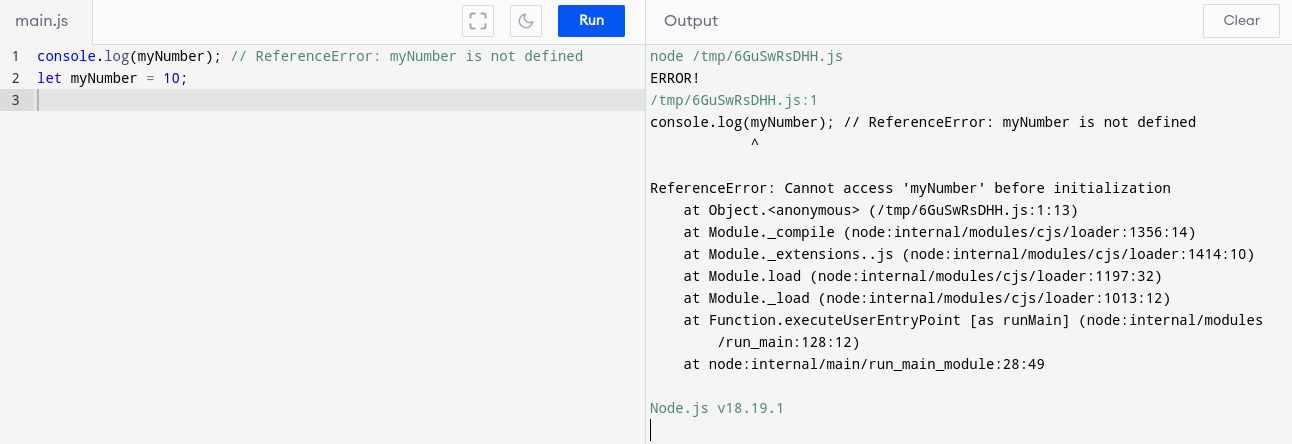
Code:
console.log(myNumber); // ReferenceError: myNumber is not defined
let myNumber = 10;
Even though myNumber is declared later, the JavaScript engine hoists the variable declaration. However, trying to use myNumber before its initialization with a value enters the TDZ, resulting in an error.
Also, I think we should also additionally remember that the TDZ is unique to let and const, not var. It exists to help you write more predictable code and avoid bugs that arise from using uninitialized variables.
Hoisting vs. let
A key distinction from var is that let variables are hoisted, but they are not given an initial value like var variables are. This is where the Temporal Dead Zone (TDZ) comes into play.
I believe that it is helpful to think of let variables as being "partially hoisted". They are brought into memory, but remain in an uninitialized state within their block.
This means that the JavaScript engine is aware of the variable's existence from the beginning of its block scope. However, attempts to access it before the line of declaration will throw a ReferenceError.
Example:
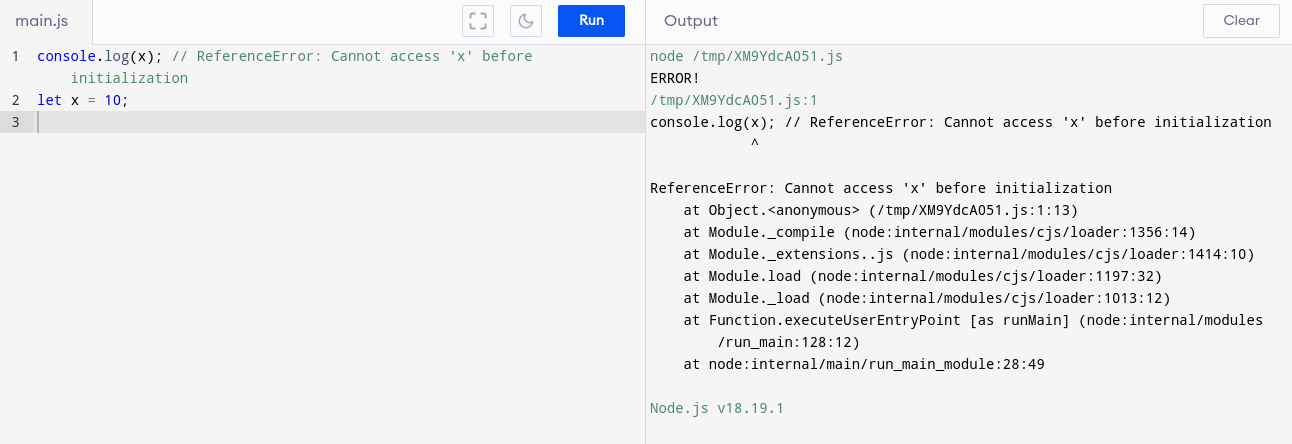
Code:
console.log(x); // ReferenceError: Cannot access 'x' before initialization
let x = 10;
So, practically, why does this matter?
With var, hoisting meant you could seemingly use a variable before its declaration line with the value undefined. This often led to confusion and unexpected behavior. let enforces order as the TDZ makes the order of your code more critical. It pushes you to declare variables before their use, resulting in more readable and predictable code.
Practical Recommendations
Let us look at some practical recommendations.
Preference for let
In modern JavaScript development, let should be your go-to keyword for declaring variables. Its block-scoping and the protection against accidental overwrites make it the safer and more versatile choice.
Why? Here is the rationale:
- Cleaner Organization: Block scoping allows you to define variables only where they are needed, reducing the risk of unintended side effects in other parts of your code.
- Prevention of Collisions: Block scoping helps avoid naming conflicts, especially within larger projects where multiple developers might be working on the same code base.
Situations for const
- True constants: Use const for values that should genuinely never be reassigned. This includes things like mathematical constants (PI), configuration settings, or values derived from calculations that shouldn't change.
- Signaling intent: const makes your code more readable by clearly indicating which values are intended to remain constant throughout their lifespan.
Example:
// Inside a function to calculate area
const PI = 3.14159;
let radius = 5;
let area = PI * radius * radius;
// ... more code using the area variable
Examples of JavaScript let
Here are two examples of using for let in JavaScript for iterating over object properties in the first one and iterating over iterable values in the second one.
for...in (Iterating Over Object Properties)
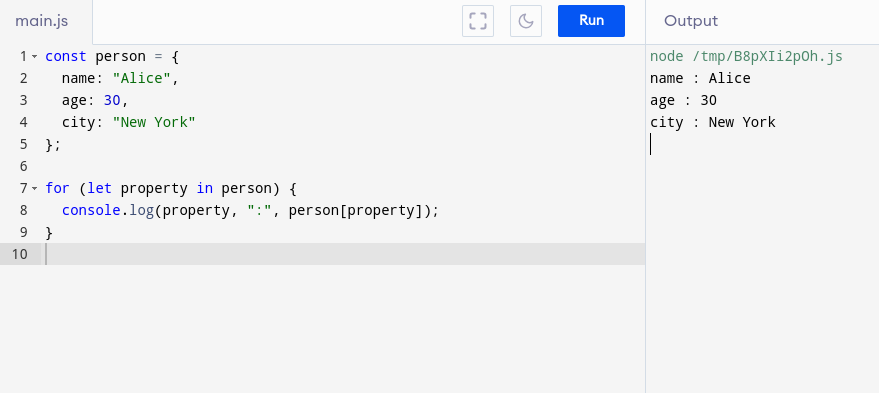
Code:
const person = {
name: "Alice",
age: 30,
city: "New York"
};
for (let property in person) {
console.log(property, ":", person[property]);
}
In this example, for...in iterates over the enumerable properties of an object. Each iteration, the property variable holds the name of the current property.
for...of (Iterating Over Iterable Values)

Code:
}
const colors = ["red", "green", "blue"];
for (let color of colors) {
console.log(color);
In the above code, for...of iterates over values in iterable objects (like Arrays, Strings, etc.). Each iteration, the color variable gets assigned the next value in the array.
We should always remember that for...in is generally intended for objects. You might get unexpected results using it on arrays if they have modified prototypes. for...of is the go-to for arrays, strings, and other built-in iterables.
Advanced Examples of JavaScript let
let Within Loops
Inside a loop, using let ensures each iteration gets its own unique copy of the loop variable. This prevents issues that often occur with var.
Example:
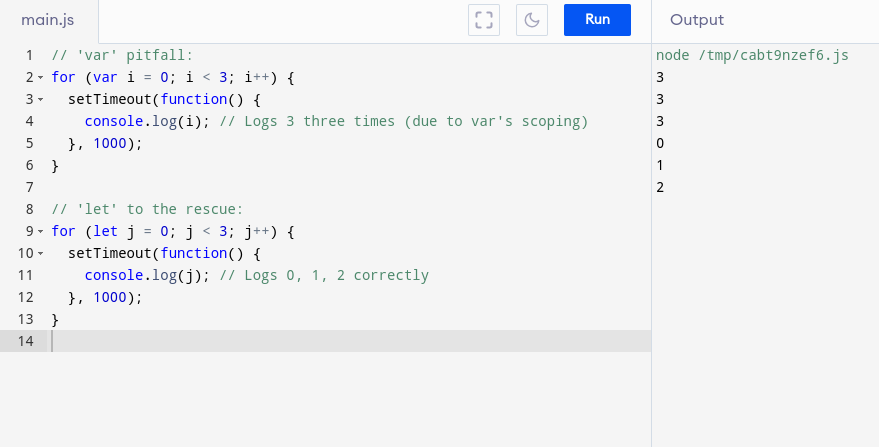
Code:
// 'var' pitfall:
for (var i = 0; i < 3; i++) {
setTimeout(function() {
console.log(i); // Logs 3 three times (due to var's scoping)
}, 1000);
}
// 'let' to the rescue:
for (let j = 0; j < 3; j++) {
setTimeout(function() {
console.log(j); // Logs 0, 1, 2 correctly
}, 1000);
// 'var' pitfall:
for (var i = 0; i < 3; i++) {
setTimeout(function() {
console.log(i); // Logs 3 three times (due to var's scoping)
}, 1000);
}
// 'let' to the rescue:
for (let j = 0; j < 3; j++) {
setTimeout(function() {
console.log(j); // Logs 0, 1, 2 correctly
}, 1000);
}
Closures and let
let within closures allows you to create functions that "remember" variables from their outer scope, even after the outer function has finished executing.
Example:
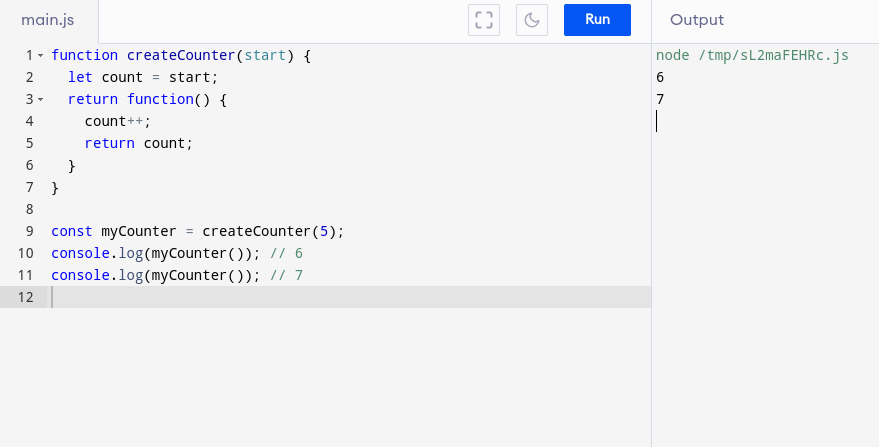
Code:
function createCounter(start) {
let count = start;
return function() {
count++;
return count;
}
}
const myCounter = createCounter(5);
console.log(myCounter()); // 6
console.log(myCounter()); // 7
Block Scoping in Conditional Statements
Using let within if, else, or other conditional blocks provides precise control over variable visibility.
Example:
if (condition) {
let message = "Success!";
// Use message here
} else {
let message = "Try again.";
// Use message here
}
// message would not be accessible outside the blocks
if (condition) {
Wrapping Up
After transitioning to using let (alongside const) as my default variable declaration keywords, I've noticed fewer unexpected scoping issues within my code. Modern JavaScript prioritizes let for its clarity and predictability. Understanding its role helps us write robust code that's easier to maintain and reason about.
The behavior of let feels more intuitive and helps me avoid common pitfalls that I might have encountered with var. Though it took some initial adjustment, I now consider let an essential tool in my JavaScript development for writing cleaner and more maintainable code.
If you wish to master technologies such as JavaScript, you can enroll in upGrad’s software engineering courses.
Frequently Asked Questions
1. Why is let important in JavaScript?
let is important because it provides block-level scoping. This helps prevent accidental variable overwrites and promotes cleaner, more predictable code.
2. How to use JavaScript let?
You use let just like you would var to declare a variable. For example: let myVariable = 10;
3. What is a JavaScript let keyword example?
Here is an example of JavaScript let keyword: if (true) {let message = "Hello!";console.log(message); // Outputs "Hello!"}console.log(message); // Would cause an error - message is not defined outside the block if ( true ) { let message = "Hello!" ; console . log ( message ) ; // Outputs "Hello!" } console . log ( message ) ; // Would cause an error - message is not defined outside the block

Author|310 articles published


upGrad Learner Support
Talk to our experts. We are available 7 days a week, 10 AM to 7 PM
Indian Nationals
Foreign Nationals
Disclaimer
The above statistics depend on various factors and individual results may vary. Past performance is no guarantee of future results.
The student assumes full responsibility for all expenses associated with visas, travel, & related costs. upGrad does not .






















-7f4b4f34e09d42bfa73b58f4a230cffa.webp&w=128&q=75)
-ae8d039bbd2a41318308f8d26b52ac8f.svg)



